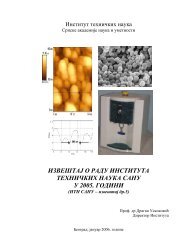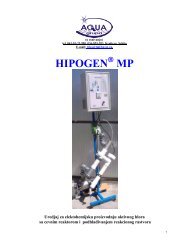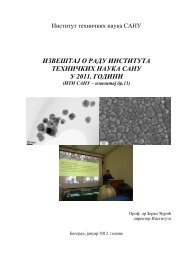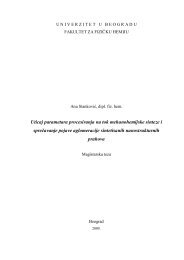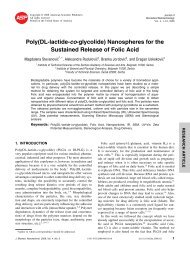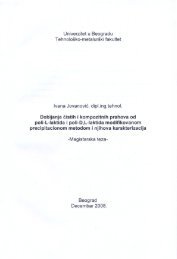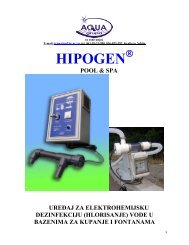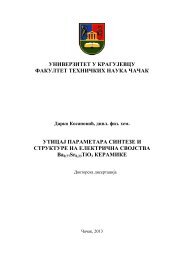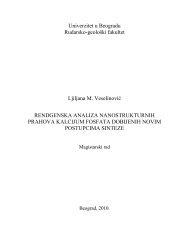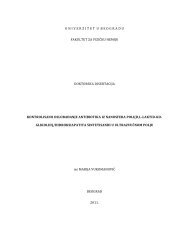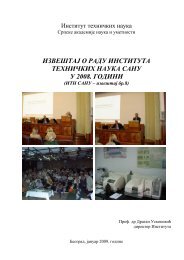Program and the Book of Abstracts (PDF) - Mrs-serbia.org.rs
Program and the Book of Abstracts (PDF) - Mrs-serbia.org.rs
Program and the Book of Abstracts (PDF) - Mrs-serbia.org.rs
Create successful ePaper yourself
Turn your PDF publications into a flip-book with our unique Google optimized e-Paper software.
Tenth Young Researche<strong>rs</strong> Conference – Materials Science <strong>and</strong> Engineering<br />
December 21-23, 2011, Hall 2, SASA, Knez Mihailova 35 & 36, Belgrade, Serbia<br />
II/1<br />
Assessment <strong>of</strong> <strong>the</strong> effects <strong>of</strong> nanoparticles <strong>of</strong> CP/PLGA<br />
on cultures <strong>of</strong> different cell lines<br />
Stevo Najman 1 , Sanja Stojanović 1 , Jelena Najdanović 1 ,<br />
Nenad Ignjatović 2 , Dragan Uskoković 2<br />
1 Unive<strong>rs</strong>ity <strong>of</strong> Niš, Faculty <strong>of</strong> Medicine, Institute <strong>of</strong> Biology <strong>and</strong> Human Genetics, Serbia<br />
2 Institute <strong>of</strong> Technical Sciences <strong>of</strong> SASA, Belgrade, Serbia<br />
The aim <strong>of</strong> this study was to examine <strong>the</strong> effects <strong>of</strong> nanoparticles <strong>of</strong> calcium phosphate/poly-<br />
(DL-lactide-co-glycolide) (NPs-CP/PLGA) on viability <strong>and</strong> growth <strong>of</strong> different cell lines in vitro.<br />
HeLa <strong>and</strong> MDCK cells were incubated with different concentrations <strong>of</strong> suspension <strong>and</strong> extract <strong>of</strong><br />
NPs-CP/PLGA. Concentrations <strong>of</strong> suspension were in <strong>the</strong> range from 1.6 µg/ml to 5000 µg/ml <strong>and</strong><br />
extract in <strong>the</strong> range from 2.5% to 50%. After incubation, MTT test was performed. Our results<br />
indicate that examined nanomaterial shows different effects depending on type <strong>of</strong> <strong>the</strong> cells, applied<br />
concentration <strong>of</strong> nanomaterial as well as whe<strong>the</strong>r it is examined suspension or extract.<br />
II/2<br />
Antibacterial activity <strong>of</strong> <strong>the</strong> copper-loaded zeolite<br />
Jelena Milenković 1 , Jasna Hrenović 2 , Nevenka Rajić 3<br />
1 Innovation Centre <strong>of</strong> <strong>the</strong> Faculty <strong>of</strong> Technology <strong>and</strong> Metallurgy, Unive<strong>rs</strong>ity <strong>of</strong> Belgrade,<br />
Belgrade, Serbia, 2 Unive<strong>rs</strong>ity <strong>of</strong> Zagreb, Faculty <strong>of</strong> Science, Division <strong>of</strong> Biology, Zagreb, Croatia,<br />
3 Unive<strong>rs</strong>ity <strong>of</strong> Belgrade, Faculty <strong>of</strong> Technology <strong>and</strong> Metallurgy, Belgrade, Serbia<br />
The aim <strong>of</strong> this study was to investigate <strong>the</strong> antibacterial activity <strong>of</strong> <strong>the</strong> copper-loaded natural<br />
zeolite (from Vranjska Banja deposit) towards Gram-negative (Escherichia coli) <strong>and</strong> Gram-positive<br />
(Staphylococcus aureus) bacteria present in different water solutions - Luria Bertani (LB) medium,<br />
syn<strong>the</strong>tic wastewater <strong>and</strong> real effluent water. The number <strong>of</strong> bacteria was measured as colony<br />
forming units (CFU) grown on LB agar after 24 h <strong>of</strong> incubation at 37 °C.<br />
The copper-loaded natural zeolite exhibits an excellent antibacterial activity <strong>and</strong> <strong>the</strong>refore could<br />
find application as a disinfectant in <strong>the</strong> final step <strong>of</strong> wastewater treatment.<br />
6





